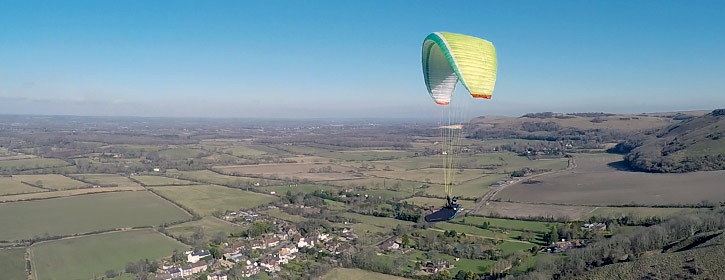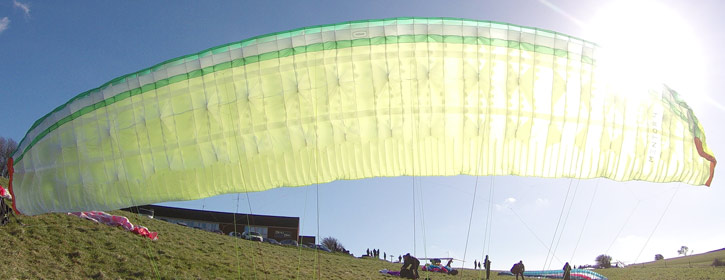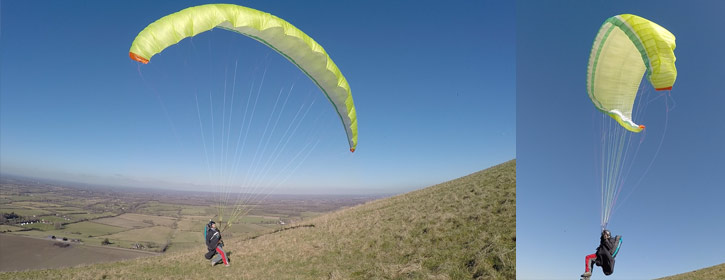Nova Mentor 4: First Flight Review (by Greg Hamerton)
The Mentor 4 is an update of the Mentor series which dominated the XC class for a long time. It gets its performance from being very steady in the air - it doesn't roll, shows limited tendency to yaw, and pitches only slightly as it moves through turbulence. For pilots who want to enjoy an extreme environment like the Alps in summer, it gives a reassuring sense of stability.

^ Get used to this view! Mentors have a cheeky way of keeping up with wings in higher classes ...

However, make no mistake! This is an XC class wing: the reaction to collapses can be dynamic, depending on what you do. It was certified as EN B, but we think it is on the high end of the scale for rate of turn and reinflation energy.
The brake travel has been shortened from the Mentor 3 (which required a heavy hand on deep brakes for a long time to stall - see our review video). The Mentor 4 reacts faster, with medium brake pressure throughout the range. A short pull of the brake slows the wing down a huge amount. It can still be made to fly very slowly, but now the stall point is much higher and the spin point is possible to reach during ordinary thermaling, which might catch some pilots in this class by surprise.


^ The trailing edge billows in the turn
In the turn it is not affected by weight shift, it doesn't really care what you do - it continues in a steady turn if the brake is engaged (the same as the Mentor 3). Efficient, but not the most agile or lively wing in the class. Trying to do wingovers, I found the energy hard to retain, the wing dampened the energy away to get me back on the straight and level. This 'detuned' handling is what I'd expect in the (lower) Progression class, but this is true to the character of this Nova series: it is a Mentor, designed to help pilots by absorbing energy, which allows relatively new pilots to access big cross country routes in big conditions. For tight, scratchy conditions there are wings with more responsive handling and greater sensitivity that would be more enjoyable to fly. As with all wings, the 'best' one depends on where you are, who you are and what you want to do.

^ In punchy conditions the wing absorbs energy well and doesn't disturb the pilot

Nova boldly claimed an increase in 0.5 glide over the already impressive Mentor 3. Looking at the familiar shape, low cell count and standard construction, it's not obvious to see how this has been achieved, and it is difficult to verify without many comparative glides from altitude in still air, so we'll have to take Nova's word for it - after all, they are basing their reputation on that claim.
Our short glides in thermic conditions showed similar performance at trim speed to the Mentor 3, Chili 3 and Iota. They were too close to tell them apart because moving air affects wings in random and often compounded ways.
Launching had the same slightly delayed pullup of the Mentor 3, and in strong winds it didn't shoot much, so it's easy and well-suited to pilots stepping up to this class for the first time. The risers are slightly stiff, long, and clean, easy to sort out and manage on the ground, and the Cs pin the wing down effectively when it's blowing the sheep off the hill.


^ Simple, slightly delayed pullup
No doubt we'll see some jaw-dropping distances this summer from Mentor 4s on banging alpine ridge-runs, as this is where the wing shines - removing thermic noise from grumpy air and thereby increasing endurance for really long flights. Certainly a worthy contender in the XC class with the 'quietest performance' you'll find, a no-fuss glider with steady handling that builds confidence by making you feel that you could easily handle more.


^ Deep brakes really grabs at the air. Effective and stable big ears.
As with all reviews, as we fly the wing more, gather more impressions from our team and observe it in action during XC flying we deepen our understanding, so if you're interested in this class of wing be sure to give us a call for the most current information and our expertise at matching pilots to the right wing.
Available to demo fly at Flybubble.
